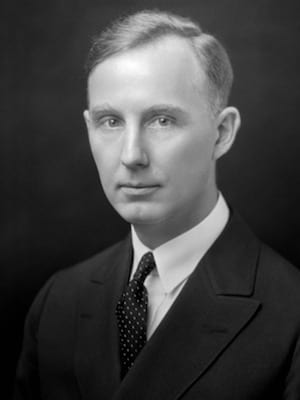Henry Woltman
Henry William Woltman (1889-1964) was an American neurologist.
He is renowned in the field of neurology, becoming the first neurologist at Mayo Clinic (Rochester), and was awarded the first PhD in neurology at the University of Minnesota.
His broad research across neurology studied tumours of the spinal cord; pernicious anaemia effects on the brain; nerve lesions in diabetes; incisura of the crus due to contralateral tumour; electroencephalography as a diagnostic aid; and a case series of stiff-man syndrome.
Woltman sign (1924) is eponymous with his name, after Woltman was the first to described a delayed muscle relaxation of the tendon reflex in hypothyroidism.
Biography
- Born on June 16, 1889, Westfield, Wisconsin, United States
- 1911 – Bachelor of Science, University of Minnesota
- 1913 – Doctor of Medicine, University of Minnesota Internship at the University of Minnesota Hospital under neurologist Professor AS Hamilton
- 1917 – Doctor of Philosophy (PhD) in neurology, University of Minnesota
- 1917 July – First assistant in neurology under Dr WD Shelden at Mayo Clinic
- 1917 – First Lieutenant in the Medical Corps of the United States Army
- 1918 – Instructor of neurology at the Mayo Graduate School of Medicine, University of Minnesota (Rochester)
- 1919 – Elected to staff at Mayo Clinic
- 1930-47 – Appointed head of the Section of Neurology and Psychiatry at Mayo Clinic
- 1931 – Appointed professor of medicine at Mayo Clinic
- 1947-54 – Chairman of the sections of neurology and psychiatry
- 1946 – Elected president of the Mayo Foundation chapter of the Society of the Sigma Xi
- 1946 – Elected president of the staff of the Mayo Clinic
- 1954 – Senior consultant in neurology
- Died on November 27, 1964 of cardiac arrest, while working at the Mayo Clinic on a history of the sections of neurology
Medical Eponyms
Woltman sign (1924/1956)
Slowness of both the contraction and the relaxation of muscles in hypothyroid patients, best seen as the “hung-up” ankle jerk and occurring because of mechanical factors and slowness of contraction time, as in myotonia and pseudomyotonia. AKA the pseudomyotonic reflex
Key Medical Attributions
Woltman’s research encompassed a wide range of neurology, including:
- diagnosis, classification, and pathological aspects of tumours of the spinal cord
- neurological manifestations and neuropathological aspects of pernicious anaemia
- pathological changes in the spinal cord and peripheral nerves in diabetes
- early advocate for electroencephalography in diagnosis
Stiff-man syndrome (progressive fluctuating muscular rigidity and spasm) – publishing a report of 14 cases in 1956, with the first observed in an Iowa farmer in 1924
Kernohan- Woltman phenomenon or Kernohan’s notch (1929) – the two authors described cases where there was misdiagnosis of the laterality of a brain lesion (compared to the autopsy confirmed location), and concluded that a brain tumour might cause the brain to be displaced with the crus of the midbrain (cerebral peduncle) to be compressed against the free edge of the tentorium cerebelli creating a notch in the crus and affecting the fibres that descend through it thereby resulting in a false localising sign.
The book ‘Clinical studies in neurology‘ was written by Mayo neurologists based on the methods described by Woltman, and dedicated to Woltman and Moersch. [Members of the Mayo Clinic Department of Neurology. Mayo Clinical Examinations in Neurology. 7e Philadelphia: Mosby, 1998]
Woltman was very active in the neurology community, taking up numerous society positions such as chariman and secretary of the section on Nervous and Mental Diseases of the American Medical Association; one of the founders of the American Board of Psychiatry and Neurology, Inc.; president of both the Minnesota Society of Neurology and Psychiatry and the Central Neuropsychiatric Association; president of the Association for Research in Nervous and Mental Diseases; and president of the American Neurological Association.
Major Publications
- Woltman HW, Wilder RM. Diabetes Mellitus: pathologic changes in the spinal cord peripheral nerves. Archives Internal Medicine 1929; 44: 576–603.
- Woltman HW. Brain changes associated with pernicious anaemia. American Journal of Physiology 1918; 45: 571–7.
- Kernohan JW, Woltman HW. Incisura of the crus due to contralateral brain tumour. Archives of Neurology and Psychiatry 1929; 21: 274–87.
- Moersch FP, Woltman MD. Progressive fluctuating muscular rigidity and spasm (‘stiff-man syndrome’). Proceedings of the Staff meetings of the Mayo Clinic 1956; 11: 421–427.
- Chaney WE. Tendon reflexes in Myxoedema: valuable aid in diagnosis. Journal of the American Medical Association 1924; 82: 2013–2016
References
- Moersch FP. Henry William Woltman MD. 1889 – 1964. Arch Neurol 1965; 13: 101–3.
- Todman D. Henry Woltman (1889-1964): Pioneering American Neurologist. J Med Biogr. 2008; 16(3): 162-6.
- Burkholder DB, Klaas JP, Kumar N, Boes CJ. The origin of Woltman’s sign of myxoedema. J Clin Neurosci. 2013; 20(9): 1204-6.
- Corbin KB, Kernohan JW. Henry William Woltman, M.D. 1889–1964. Neurology. 1965; 15(4): 413.
- Bibliography. Woltman, Henry W. WorldCat Identities
[cite]
Doctor in Australia. Keen interest in internal medicine, medical education, and medical history.

